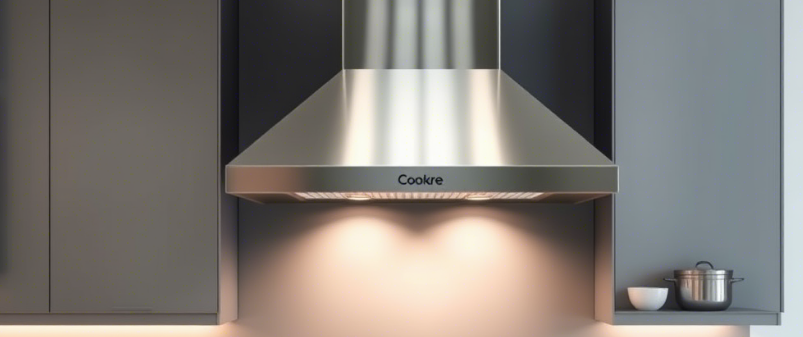
Cooker Range Hood — Essential Kitchen Equipment for Clean & Comfortable Cooking

Spend enough time in a kitchen — professional or home — and you quickly realize that good ventilation isn’t a luxury. It’s a necessity.
As a working chef, I can tell you: nothing ruins a cooking experience faster than a kitchen filled with smoke, grease, and heat. That’s why a cooker range hood (sometimes called an extractor hood) is one of the most valuable pieces of equipment above any stove.
It doesn’t just keep your kitchen air clean — it makes cooking safer, more comfortable, and frankly, more enjoyable.
What is a Cooker Range Hood?
As a professional chef who spends hours every day around sizzling pans and roaring burners, I can tell you firsthand: a cooker range hood isn’t just a kitchen accessory — it’s an essential tool.
A cooker range hood is an appliance installed above your stove or cooktop. Its job? To pull smoke, grease particles, moisture, and lingering odors out of your kitchen air while you cook. Some models filter and recirculate the air back into the kitchen, while others vent it directly outside. Both types serve a purpose depending on your setup.
If you’re serious about cooking — even if you just love preparing great meals at home — a good range hood can transform your kitchen experience.
Why Every Serious Cook Needs a Range Hood
Removes Cooking Smoke & Steam
Whenever I sear a thick steak or stir-fry vegetables over high heat, clouds of smoke and steam are inevitable. Without a range hood, all that ends up clinging to your walls, ceilings, and lungs. A powerful hood whisks it away before it settles.
Filters Out Grease Particles
You might not see them immediately, but cooking sends tiny grease droplets into the air. Without a hood, they land on your cabinets, your countertops, and even your ceiling. Trust me — over time, it’s a nightmare to clean. A hood with strong filtration catches most of it.
Controls Kitchen Odors
I love the smell of onions caramelizing or garlic sizzling, but I don’t want to smell it in my living room three days later. A range hood helps clear out strong cooking odors before they have a chance to stick.
Reduces Heat Buildup
Cooking heats up a kitchen fast, especially smaller ones. A good range hood doesn’t just clear the air; it helps remove excess heat, making the space much more comfortable when you’re juggling multiple dishes.
Improves Air Quality
When you cook daily like I do, breathing cleaner air isn’t just a luxury — it’s a necessity. Removing smoke, grease, and vapor improves overall indoor air quality, which is better for your lungs, your furniture, and your walls.
Types of Cooker Range Hoods (And When to Use Them)
| Type | Best For |
|---|---|
| Ducted / Vented | Heavy-duty cooking, large kitchens — pulls air outside |
| Ductless / Recirculating | Apartments, smaller kitchens — filters air and returns it |
| Downdraft Ventilation | Kitchen islands, minimalist setups — pulls air downward |
| Under-Cabinet Hood | Compact spaces — fits neatly beneath cabinets |
| Wall-Mounted Chimney Hood | Open kitchens, design features — stylish and effective |
In my restaurant setups, ducted hoods always win. In smaller home kitchens, though, a well-designed ductless hood can work surprisingly well with regular filter changes.
Key Features to Look For in a Cooker Range Hood
Extraction Power (CFM Rating)
CFM (cubic feet per minute) measures how much air the hood can move. For most homes, 300–600 CFM is enough. But for serious cooks who love searing, wok cooking, or grilling indoors, more is better — I recommend aiming for 700+ CFM if you can.
Noise Level
Powerful hoods can sound like jet engines if you’re not careful. Look for a model that balances power with noise — measured in sones or decibels. I aim for something strong but still allows conversation.
Filters
- Aluminum Mesh Filters: Easy to clean, decent for moderate cooking.
- Charcoal Filters: Found in ductless models, perfect for odor control.
- Baffle Filters: Heavy-duty and ideal if you’re constantly frying or grilling.
Personally, I prefer baffle filters — they handle grease like a champ and last forever if maintained.
Lighting
Good built-in lighting is a game-changer. I always recommend LED or halogen lights — they make it easier to judge caramelization and monitor sauces.
Size
Your hood should be at least as wide as your cooktop — wider is even better. Coverage is key to capturing all the smoke and fumes.
Installation Tips from Chef Marcus
Over the years, I’ve seen and fixed my share of bad range hood installations. Here’s what I’ve learned:
- Higher CFM needs bigger ducts. Don’t restrict airflow with narrow piping — it ruins efficiency.
- Clean your filters monthly. Especially if you cook often. Grease buildup will destroy performance fast.
- Mount it at the right height. 24–30 inches above the cooktop is the sweet spot — too close and you risk overheating, too far and it loses effectiveness.
- Choose ducted if you can. Venting outside always works better than recirculating back into the room.
Cooker Range Hood Maintenance
| Task | Frequency |
|---|---|
| Clean Grease Filters | Every 3–4 weeks |
| Replace Charcoal Filters | Every 3–6 months |
| Wipe Down Exterior | Weekly |
| Check for Airflow Blockage | Annually |
Stay on top of these simple tasks, and your hood will keep running like a dream for years.
Alternatives if You Don’t Have a Range Hood
Not every kitchen is equipped with a range hood — I get it. I’ve cooked in plenty of tiny apartments and pop-up kitchens. Here’s what I suggest if you don’t have one:
- Open windows wide while cooking. Cross-ventilation is your friend.
- Use a window fan. Position it to pull air outward, not inward.
- Cook on the back burners. That keeps smoke and steam closer to the venting window.
- Keep a portable air purifier nearby. It helps with odors and fine particles.
- Wipe down surfaces often. Prevents grease buildup over time.
It’s not perfect — but it’s far better than letting smoke and grease settle everywhere.
Popular Cooker Range Hood Brands and Models
After working in countless kitchens — both professional and home setups — I’ve seen which range hood brands truly stand the test of time. If you’re shopping for a quality cooker hood, here are some of the brands and models I recommend based on real-world experience.
Broan-NuTone
Broan is a classic, especially for reliable under-cabinet and wall-mounted hoods.
- Popular model: Broan-NuTone 413004
- Why I like it: Affordable, easy to install, great for smaller kitchens.
Zephyr
Zephyr specializes in stylish, high-performance range hoods.
- Popular model: Zephyr AK2100BS
- Why I like it: Quiet operation and serious extraction power without overwhelming the kitchen with noise.
FOTILE
FOTILE is a fantastic choice if you do a lot of stir-frying or heavy-duty cooking.
- Popular model: FOTILE JQG7501
- Why I like it: Powerful suction with a unique slanted design that captures smoke and grease incredibly well.
KitchenAid
KitchenAid range hoods blend performance with sleek design — ideal if aesthetics are important to you.
- Popular model: KitchenAid KVWB406DSS
- Why I like it: Stylish stainless-steel look with strong ventilation and quiet settings.
Cosmo
If you’re looking for good value without sacrificing performance, Cosmo is a brand to consider.
- Popular model: Cosmo 63175S
- Why I like it: Great for budget-conscious buyers, offers powerful suction and LED lighting.
No matter which brand you choose, always check the CFM rating, noise levels, and the type of filters it uses to make sure it fits your cooking style.
FAQ – Cooker Range Hoods
Is it better to have a ducted or ductless range hood?
If you have the option, always go with a ducted hood. Venting the air outside removes smoke, odors, and grease far more effectively than recirculating it back into the room.
How often should I clean the range hood filters?
If you cook regularly, clean grease filters every 3–4 weeks. For charcoal filters in ductless models, replace them every 3–6 months.
Can I install a range hood myself?
Yes, especially for ductless models or simple under-cabinet hoods. However, if you need to install ductwork for a vented hood, I recommend hiring a professional to ensure proper airflow and safe installation.
How loud are cooker range hoods?
It depends on the CFM power. Higher CFM often means more noise, but modern models balance power and quiet operation well. Look for hoods rated below 6 sones for comfortable use.
What size range hood do I need?
Your hood should be at least as wide as your cooktop. Ideally, it should extend a few inches beyond on each side for maximum capture efficiency.
Can I use a downdraft system instead of a traditional hood?
Yes, especially if you have a kitchen island or want a minimalist look. Downdraft vents pull air downward near the cooktop, but they are typically less powerful than overhead hoods.
Do range hoods need to be vented outside?
Not necessarily. Ductless range hoods filter and recirculate air back into the kitchen. However, venting outside is always the more effective option if possible.
How high should a range hood be mounted?
Generally, mount the hood 24–30 inches above the cooking surface. Always check the manufacturer’s recommendations for specific guidelines.
Can I add a range hood in an apartment?
Absolutely. Ductless, recirculating models are perfect for apartments where venting outside isn’t possible.
What’s the difference between mesh filters and baffle filters?
Mesh filters are lighter and easier to clean, but they can clog faster. Baffle filters are heavier, more durable, and better suited for heavy-duty cooking like frying or grilling.